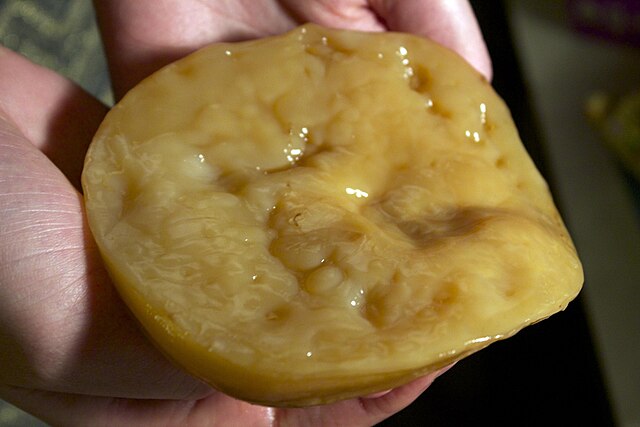Mother of vinegar is a biofilm composed of a form of cellulose, yeast, and bacteria that sometimes develops on fermenting alcoholic liquids during the process that turns alcohol into acetic acid with the help of oxygen from the air and acetic acid bacteria (AAB). It is similar to the symbiotic culture of bacteria and yeast (SCOBY) mostly known from production of kombucha, but develops to a much lesser extent due to lesser availability of yeast, which is often no longer present in wine/cider at this stage, and a different population of bacteria. Mother of vinegar is often added to wine, cider, or other alcoholic liquids to produce vinegar at home, although only the bacteria is required, but historically has also been used in large scale production.
Slab of mother of vinegar taken from a fermentation tank.
Mother of vinegar that is composed of Acetobacter.
Bacterial culture of mother of vinegar
Store-bought vinegar with mother of vinegar at the bottom.
Symbiotic culture of bacteria and yeast (SCOBY) is a culinary symbiotic fermentation culture (starter) consisting of lactic acid bacteria (LAB), acetic acid bacteria (AAB), and yeast which arises in the preparation of sour foods and beverages such as kombucha. Beer and wine also undergo fermentation with yeast, but the lactic acid bacteria and acetic acid bacteria components unique to SCOBY are usually viewed as a source of spoilage rather than a desired addition. Both LAB and AAB enter on the surface of barley and malt in beer fermentation and grapes in wine fermentation; LAB lowers the pH of the beer/wine while AAB takes the ethanol produced from the yeast and oxidizes it further into vinegar, resulting in a sour taste and smell. AAB are also responsible for the formation of the cellulose SCOBY.
A SCOBY used for brewing kombucha.
Kombucha co-culture with SCOBY biofilm
A group of kombucha SCOBYs







